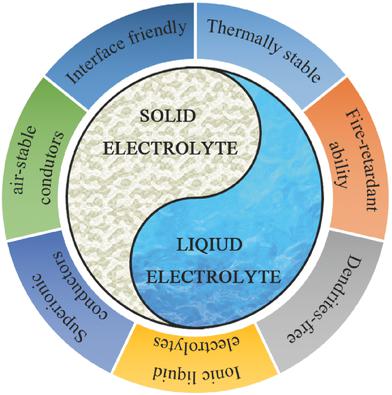当前位置:
X-MOL 学术
›
Adv. Energy Mater.
›
论文详情
Our official English website, www.x-mol.net, welcomes your
feedback! (Note: you will need to create a separate account there.)
Designing Safe Electrolyte Systems for a High‐Stability Lithium–Sulfur Battery
Advanced Energy Materials ( IF 24.4 ) Pub Date : 2018-01-17 , DOI: 10.1002/aenm.201702348 Wei Chen 1, 2, 3 , Tianyu Lei 1 , Chunyang Wu 1 , Min Deng 1 , Chuanhui Gong 1 , Kai Hu 1 , Yinchang Ma 1 , Liping Dai 1 , Weiqiang Lv 4 , Weidong He 4 , Xuejun Liu 2, 3 , Jie Xiong 1 , Chenglin Yan 2, 3
Advanced Energy Materials ( IF 24.4 ) Pub Date : 2018-01-17 , DOI: 10.1002/aenm.201702348 Wei Chen 1, 2, 3 , Tianyu Lei 1 , Chunyang Wu 1 , Min Deng 1 , Chuanhui Gong 1 , Kai Hu 1 , Yinchang Ma 1 , Liping Dai 1 , Weiqiang Lv 4 , Weidong He 4 , Xuejun Liu 2, 3 , Jie Xiong 1 , Chenglin Yan 2, 3
Affiliation

|
Safety, nontoxicity, and durability directly determine the applicability of the essential characteristics of the lithium (Li)‐ion battery. Particularly, for the lithium–sulfur battery, due to the low ignition temperature of sulfur, metal lithium as the anode material, and the use of flammable organic electrolytes, addressing security problems is of increased difficulty. In the past few years, two basic electrolyte systems are studied extensively to solve the notorious safety issues. One system is the conventional organic liquid electrolyte, and the other is the inorganic solid‐state or quasi‐solid‐state composite electrolyte. Here, the recent development of engineered liquid electrolytes and design considerations for solid electrolytes in tackling these safety issues are reviewed to ensure the safety of electrolyte systems between sulfur cathode materials and the lithium‐metal anode. Specifically, strategies for designing and modifying liquid electrolytes including introducing gas evolution, flame, aqueous, and dendrite‐free electrolytes are proposed. Moreover, the considerations involving a high‐performance Li+ conductor, air‐stable Li+ conductors, and stable interface performance between the sulfur cathode and the lithium anode for developing all‐solid‐state electrolytes are discussed. In the end, an outlook for future directions to offer reliable electrolyte systems is presented for the development of commercially viable lithium–sulfur batteries.
中文翻译:

为高稳定性锂硫电池设计安全的电解质系统
安全性,无毒性和耐用性直接决定了锂(Li)离子电池基本特性的适用性。特别是对于锂硫电池,由于硫的着火温度低,金属锂作为负极材料以及使用易燃有机电解质,解决安全性问题的难度越来越大。在过去的几年中,为解决臭名昭著的安全问题,对两种基本的电解质系统进行了广泛的研究。一种体系是常规的有机液体电解质,另一种体系是无机固态或准固态复合电解质。这里,回顾了工程液体电解质的最新发展以及解决这些安全问题的固体电解质设计注意事项,以确保在硫阴极材料和锂金属阳极之间的电解质系统的安全性。具体来说,提出了设计和修改液体电解质的策略,包括引入气体逸出,火焰,水和无枝晶的电解质。此外,涉及高性能锂电池的考虑讨论了+导体,空气稳定的Li +导体以及用于开发全固态电解质的硫阴极和锂阳极之间的稳定界面性能。最后,提出了发展可靠的电解质系统的未来方向的展望,以开发商业上可行的锂硫电池。
更新日期:2018-01-17
中文翻译:

为高稳定性锂硫电池设计安全的电解质系统
安全性,无毒性和耐用性直接决定了锂(Li)离子电池基本特性的适用性。特别是对于锂硫电池,由于硫的着火温度低,金属锂作为负极材料以及使用易燃有机电解质,解决安全性问题的难度越来越大。在过去的几年中,为解决臭名昭著的安全问题,对两种基本的电解质系统进行了广泛的研究。一种体系是常规的有机液体电解质,另一种体系是无机固态或准固态复合电解质。这里,回顾了工程液体电解质的最新发展以及解决这些安全问题的固体电解质设计注意事项,以确保在硫阴极材料和锂金属阳极之间的电解质系统的安全性。具体来说,提出了设计和修改液体电解质的策略,包括引入气体逸出,火焰,水和无枝晶的电解质。此外,涉及高性能锂电池的考虑讨论了+导体,空气稳定的Li +导体以及用于开发全固态电解质的硫阴极和锂阳极之间的稳定界面性能。最后,提出了发展可靠的电解质系统的未来方向的展望,以开发商业上可行的锂硫电池。









































 京公网安备 11010802027423号
京公网安备 11010802027423号